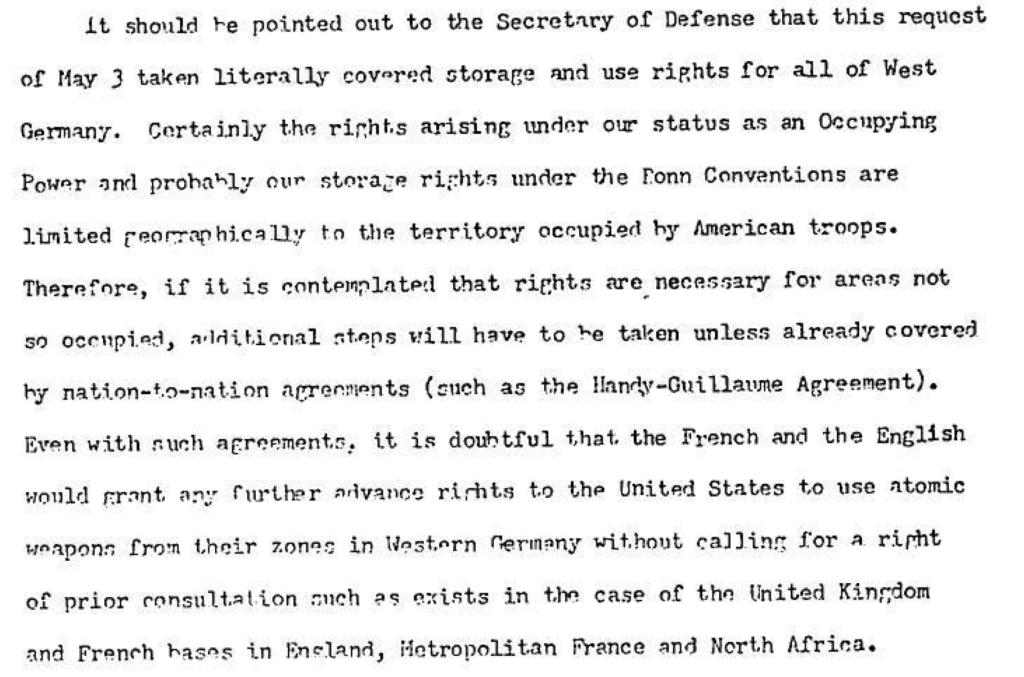In this 2006 interview with Francis Slakey and Jennifer Ouellette, Sidney Drell and Richard Garwin, Slakey asked “When nuclear weapons were first developed, under what circumstances would a president authorize the use of those weapons?”
Garwin:
Nuclear weapons were a scarcity. We finished the war with maybe one nuclear weapon in August of 1945 and had relatively few. And, in fact, the people at Los Alamos had very different views, it turns out of the future. Hans Bethe, shortly before he died, commented that “Nobody at Los Alamos believed that there would be thousands or tens of thousands of nuclear weapons.” And yet, I gave a talk in November 2005, parallel to a November 1945 talk by Robert Oppenheimer, who in his speech to the American, to the National Academy and the American Philosophical Society said that, in 1945, “If there were to be a war between two nuclear-armed countries they would be used by the tens of thousands; by the thousands or the tens of thousands.” So, between these two people who were intimately involved in the creation of nuclear weapons, and Hans Bethe throughout his life afterwards, to have such different views is quite striking. But, nuclear weapons belonged to the civilian side, to the Atomic Energy Commission, for a long time before control was transferred in the field to the military, in part as a result or aided by the permissive action links that were then introduced. It’s the president though, in principle, who can release nuclear weapons. However, he can delegate that responsibility and authority to anybody he wants.
Drell:
I would add to that that the additional period right after the war, the great effort was to try and control the spread of nuclear technology and nuclear weapons, and they were certainly under presidential control. But the first envisaged use was to confront the large Soviet army in Europe as NATO was being built. And they were a substitute for large manpower if the Soviets had moved west. But, when thermonuclear weapons increased the destructive potential of these weapons by factors of a thousand beyond Hiroshima and Nagasaki people soon realized that these are weapons of suicide and it was, I think, President Eisenhower who first said, in 1956, that, you know, “Because of their destructiveness war was no longer just exhaustion of the enemy and surrender but it had become destruction of the enemy and suicide.” Those were very close to his exact words. And so the whole policy at that point was to prevent their use. And so, that’s how the deterrent idea, based on mutual assured destruction, grew up, because there was no defense against them and there was absolutely the highest priority to see that they weren’t used, and so the idea of deterrence. Namely, having a capacity to respond to the worst possible attack upon you and destroy the attacker, therefore to convince him he would be committing suicide if he attacked you was the basis for our arsenal.
Garwin:
Yeah. Exactly right. And when Eisenhower came in, though, he regarded nuclear weapons as a “bigger bang for the buck.” And, that was just at the beginning of the era of tactical nuclear weapons, which paradoxically were encouraged by some of our physicist colleagues as a way of reducing the emphasis on bigger and more numerous strategic weapons whose only purpose would be to destroy society. But, in fact no good deed goes unpunished and pretty soon with the proliferation on our side and the Soviet side of tactical nuclear weapons, and the response of the reformation, reformation of the army structure to be less vulnerable to nuclear weaponry, the nuclear weapons used in combat would kill three tanks, five tanks, or whatever. That same nuclear weapon, used against a city could kill hundreds of thousands of people. And so, what we were doing was to proliferate in our two arsenals vast numbers of strategic weapons, only calling them tactical weapons, and those would be very bad if ever used in warfare. There would be no guarantee that if we used our tactical nuclear superiority and stopped Warsaw Pact armies on their march to the West that the Soviets wouldn’t escalate and use nuclear weapons to compel surrender by using them on cities, in fact. And, not only no guarantee; it was to my mind, absolutely certain that they would do that. And so, then there were all kinds of theories of escalation. But, to go back to deterrence, in 1945, especially ‘49 when the Soviets tested their first nuclear weapon, there was panic among the populace and an attempt by a far-sighted people even before that to obtain active defense against the aircraft that would deliver nuclear weapons. And pretty soon it became apparent that we could no effective defense. So, Bernard Brodie and others, strategists, said “Never mind. We can be protected even without defense if we maintain a survivable, commandable nuclear force so that the Soviet nuclear weapons would essentially be turned back upon themselves, that is with high assurance a use of nuclear weapons against the United States by the Soviet Union would result in the destruction of the Soviet Union. So, it was that tenuous, difficult balance, which was not a numerical balance at all, that was responsible for security for so many decades. Now it’s more difficult. If nuclear weapons are obtained by people without home bases or without values it’s hard to deter them when their only purpose may simply be to kill on the other side.




